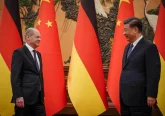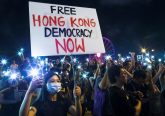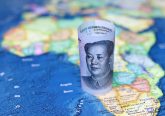The iconic statue of the first American postmaster general Benjamin Franklin greets visitors to the Old Post Office Pavilion in the heart of the US capital: Washington, DC. The edifice is now home to the luxurious and controversial Trump International Hotel on Pennsylvania Avenue at the mid-point between the US Capitol Building and the White House.
The hotel webpage invites guests to “share tea” in the Benjamin Bar to discuss “social and economic affairs” as it was the “‘established custom’” in colonial America. It further states that “we agree with Franklin” and delight to “serve tea from China.”
The page indicates that Franklin had stated “‘at least a million Americans drink tea twice a day,’” Yet, he was “unable to find any American tea as palatable or agreeable as real tea from China.”
THE FOUNDING CHINOISERIES
Franklin was one of many among the founding generation that not only enjoyed tea, but also idolized China’s literary culture and commercial intercourse. Similar to today, the Middle Kingdom’s influence was so powerful that American colonial life was saturated with Chinese teas, silks, porcelains, wallpapers, Chinese Chippendale furniture, and other products.
Like Franklin, President George Washington also had an affinity for Chinese tea as well as porcelain, importing several collections of the latter. Washington—a farmer in his pastime—kept detailed records of flowers from “Chinese seeds” at his Mount Vernon estate. Similarly, Thomas Jefferson studied Chinese gardening and architectural design for use at his Monticello home in Virginia. To overcome commercial dependence on British imports, Dr. Benjamin Rush attempted to set up “a china manufactory” for “the service of America” in Philadelphia.
Acting like a Confucius’s disciple, Franklin promoted Confucian ethics and Chinese moral philosophy in his weekly newspaper, Pennsylvania Gazette. The colonial sage explained to readers how Confucian principles could provide the framework for a “happy and flourishing empire” in America. Franklin also commented that the “Chinese are regarded as an ancient and highly civilized nation” from which Americans might learn to form their own civilization. By linking Confucius to Jesus in The Age of Reason (1794), Thomas Paine—a revolutionary pamphleteer—also maintained that the Chinese were “a people of mild manners and of good morals.”
Secretary Charles Thomson of the American Philosophical Society (later the secretary of the Continental Congress) compared the two countries, saying that Philadelphia “lies in the 40th degree of north latitude of very same as Pekin [Beijing] in China,” and that the comparable “soil and climate” would help the city to “thrive in a degree equal to our warmest expectations.” Thomson went on to say, “This country may be improved beyond” what “might have been expected” if we could be “so fortunate as to introduce the industry of the Chinese, their arts of living and improvements in husbandry, as well as their native plants, America might in time become as populous as China, which is [sic] allow to contain more inhabitants than any other country, of the same extent, in the world.”
At that time, the Chinese population was approximately 300 million, while the American colonies had only slightly over two million. Franklin, the founder of the Society, concluded that China was a role model and hoped that “America would in time come to possess much likeness in the wealth of its industries to China.”
COMMERCIAL INTERCOURSE
Like the monks and merchants in ancient China, the Pilgrims and colonists in America presented a similar evolution in search of spiritual happiness and material wealth. Jefferson and other founding fathers established the “republic” with trade and commerce in mind for its prosperity, unity, and “the Pursuit of Happiness.”
Inspired by the experience of the Pilgrims and colonists, the Constitution was designed to unite the diverse nation with its “Commerce Clause” enshrined in the sacred document. The clause gives Congress the power “to regulate Commerce with foreign Nations, and among the several States, and with the Indian Tribes.”
Establishing a commercial relationship with China was an institutional vision of the republic as the founding generation sought to free themselves from the yoke of British and other colonial powers. Nevertheless, the Virginia charter of the colonists—which sought “a shortcut to China” by giving instructions to navigate through the James River “toward the North-West” Pacific Territory—remained an intriguing text.
As the third US president, Jefferson dispatched the Lewis and Clark Expedition to search for the navigational waterway to China. The instructions for the Expedition clearly stated that finding a direct channel to the Pacific coast—through the newly-acquired Louisiana Purchase and the Pacific Northwest Territory—was for “the purpose of commerce.”
HISTORY CONTINUES
With this backdrop, the more than 240 years of evolving cultural exchange and commercial intercourse between China and the United States will likely continue for the greater benefit of both—with or without President Trump’s “trade war” rhetoric.
For example, there are already more than 100 Confucius Institutes across America, while Chinese state-owned enterprises have invested in in Kansas, Ohio, Virginia, and other states. Governors and congressional leaders have recognized the win-win nature for their states and districts that is generally better than the tariff on Chinese imports with potentially negative consequences.
Moreover, Trump’s loans are from the Bank of China and the Industrial and Commercial Bank of China’s leasing of Trump Tower in New York City, indicate that the President himself has an incentive to maintain good trade relations with China. Indeed, President Trump’s family and inner circle of advisors and his cabinet of like-minded tycoons and financiers appear to be mindful of the historically close Sino-American relationship. After withdrawing from President Barack Obama’s 12-nation Trans-Pacific Partnership, it seems that Trump intends to chart a new bilateral approach to China under the new of transactional “America First.”
Representing Trump at the World Economic Forum in Davos, American financier and former White House director of communications Anthony Scaramucci described the United States as the apostle of “free trade.” He then said that President Trump wanted an “excellent relationship with the Chinese” that would eventually “create symmetry” within a broader framework of other contested issues of Taiwan, North Korea, the South China Sea, among others. As anybody could guess, this seems to indicate that as the campaign “headlines” fade away after the election, the historic “trendlines” have quietly been revived.
It remains to be seen whether the White House director’s hopeful sentiments on Sino-American trade will become as “palatable or agreeable as real tea from China” on Trump’s menu at the Benjamin Bar, or instead be treated like the boxes of Chinese tea that led to the Boston Tea Party and the Revolutionary War.






